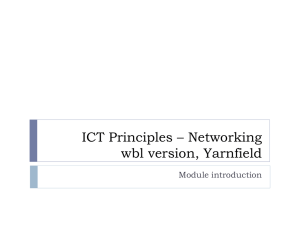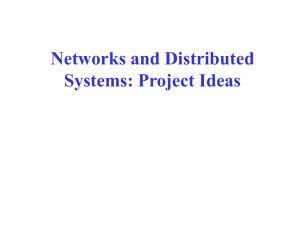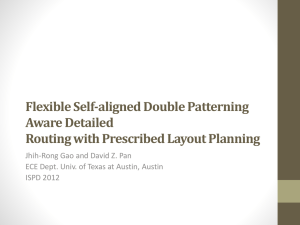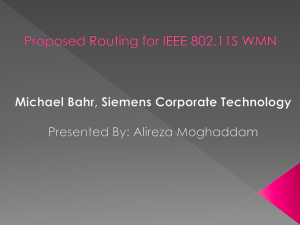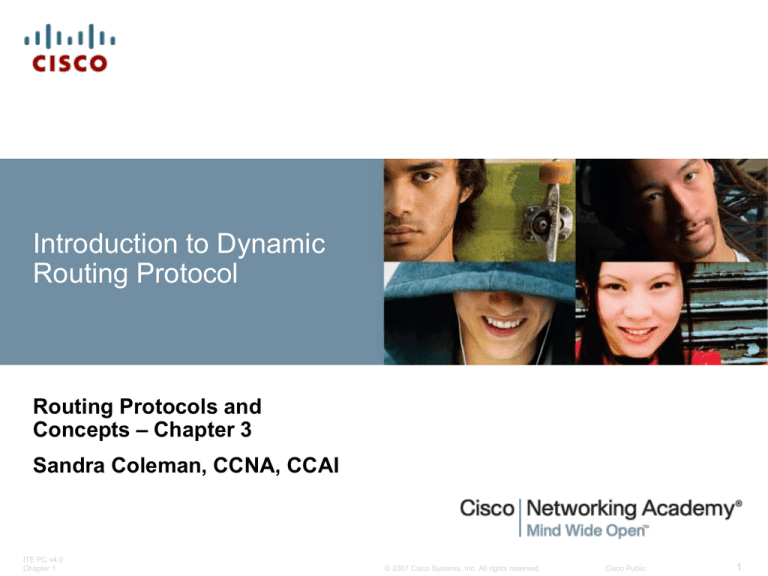
Introduction to Dynamic
Routing Protocol
Routing Protocols and
Concepts – Chapter 3
Sandra Coleman, CCNA, CCAI
ITE PC v4.0
Chapter 1
© 2007 Cisco Systems, Inc. All rights reserved.
Cisco Public
1
Objectives
Describe the role of dynamic routing protocols and
place these protocols in the context of modern
network design.
Identify several ways to classify routing protocols.
Describe how metrics are used by routing protocols
and identify the metric types used by dynamic routing
protocols.
Determine the administrative distance of a route and
describe its importance in the routing process.
Identify the different elements of the routing table.
ITE PC v4.0
Chapter 1
© 2007 Cisco Systems, Inc. All rights reserved.
Cisco Public
2
Overview of dynamic routing protocols
ITE PC v4.0
Chapter 1
© 2007 Cisco Systems, Inc. All rights reserved.
Cisco Public
3
Dynamic Routing Protocols
Function(s) of Dynamic Routing Protocols:
-Dynamically share information between routers.
-Automatically update routing table when topology changes.
-Determine best path to a destination.
ITE PC v4.0
Chapter 1
© 2007 Cisco Systems, Inc. All rights reserved.
Cisco Public
4
Dynamic Routing Protocols
The purpose of a dynamic routing protocol is to:
-Discover remote networks
-Maintaining up-to-date routing information
-Choosing the best path to destination networks
-Ability to find a new best path if the current path is no longer
available
-They can NOW SHARE information with each other!
ITE PC v4.0
Chapter 1
© 2007 Cisco Systems, Inc. All rights reserved.
Cisco Public
5
Dynamic Routing Protocols
Components of a routing protocol
Algorithm
In the case of a routing protocol, algorithms are used for
facilitating routing information and best path determination
Routing protocol messages
These are messages for discovering neighbors and
exchange of routing information
ITE PC v4.0
Chapter 1
© 2007 Cisco Systems, Inc. All rights reserved.
Cisco Public
6
Dynamic Routing Protocols
Advantages of static routing
-It can backup multiple interfaces/networks on a router
-Easy to configure
-No extra resources are needed
-More secure
-Administrator maintains control over the routing process
Disadvantages of static routing
-Network changes require manual reconfiguration
-Does not scale well in large topologies
ITE PC v4.0
Chapter 1
© 2007 Cisco Systems, Inc. All rights reserved.
Cisco Public
7
Classifying Routing Protocols
Dynamic routing protocols are grouped according to
characteristics. Examples include:
-RIP
-IGRP
-EIGRP
-OSPF
-IS-IS
-BGP
Autonomous System is a group of routers under the control of
a single authority.
ITE PC v4.0
Chapter 1
© 2007 Cisco Systems, Inc. All rights reserved.
Cisco Public
8
Classifying Routing Protocols
Types of routing protocols:
-Interior Gateway Protocols (IGP) – routing within an AS
-Exterior Gateway Protocols (EGP) – routing between AS’s
ITE PC v4.0
Chapter 1
© 2007 Cisco Systems, Inc. All rights reserved.
Cisco Public
9
Classifying Routing Protocols
Interior Gateway Routing Protocols (IGP)
-Used for routing inside an autonomous system & used to route
within the individual networks themselves.
-Examples: RIP, EIGRP, OSPF
Exterior Routing Protocols (EGP)
-Used for routing between autonomous systems
-Example: BGPv4
ITE PC v4.0
Chapter 1
© 2007 Cisco Systems, Inc. All rights reserved.
Cisco Public
10
IGP Protocols
Distance vector (RIP, EIGRP)
– routes are advertised as vectors of distance & direction.
– incomplete view of network topology. (only sees its neighbors)
– Generally, periodic updates. (30-, 90-seconds, etc.) are sent ONLY
to neighboring routers
– Work best in a simple, flat network or a hub-and-spoke topology
–Admins do NOT have to be very knowledgable
Link state (OSPF)
– complete view of network topology is created. (Sees EVERYONE –
like a map)
– Knowledgeable administrators
– updates are not periodic. (triggered by a change)
– Quicker convergence
– Should be used in larger organizations with more than 5 routers
(especially if some of them are NOT Cisco routers)
ITE PC v4.0
Chapter 1
© 2007 Cisco Systems, Inc. All rights reserved.
Cisco Public
11
Classifying Routing Protocols
Classful routing protocols
Do NOT send subnet mask in
routing updates
DO NOT support VLSM
RIPv1 and IGRP
Classless routing
protocols
DO send subnet mask in
routing updates.
Supports VLSM
RIPv2, EIGRP, OSPF, IS-IS,
BGP
ITE PC v4.0
Chapter 1
© 2007 Cisco Systems, Inc. All rights reserved.
Cisco Public
12
Classifying Routing Protocols
Convergence is defined as when all routers’ routing
tables are at a state of consistency (They all have the
SAME level of knowledge)
ITE PC v4.0
Chapter 1
© 2007 Cisco Systems, Inc. All rights reserved.
Cisco Public
13
Convergence
Fast convergence is VERY desirable, especially when
using dynamic routing protocols.
WHY? Routers could make incorrect forwarding
decisions if the topology is NOT converged.
ITE PC v4.0
Chapter 1
© 2007 Cisco Systems, Inc. All rights reserved.
Cisco Public
14
Routing Protocols Metrics
Metric
A value used by a routing protocol to determine which
routes are better than others.
See the RIP example below!
ITE PC v4.0
Chapter 1
© 2007 Cisco Systems, Inc. All rights reserved.
Cisco Public
15
Routing Protocols Metrics
Metrics used in IP routing protocols
-Bandwidth – Highest preferred (EIGRP)
-Cost – value determined by IOS or by network admin.
-Delay – time to traverse a path
-Hop count - # routers packet must pass through (RIP)
-Load – traffic utilization on a certain link
-Reliability – probability of a link failure (based on an algorithm)
You don’t need to understand all of these right now,
we’ll discuss them as we get to the protocol they apply
to.
ITE PC v4.0
Chapter 1
© 2007 Cisco Systems, Inc. All rights reserved.
Cisco Public
16
Metric Example
ITE PC v4.0
Chapter 1
© 2007 Cisco Systems, Inc. All rights reserved.
Cisco Public
17
Routing Protocols Metrics
The Metric Field in the
Routing Table
Metric used for each
routing protocol
-RIP - hop count (lowest
wins)
-IGRP & EIGRP Bandwidth (used by
default), Delay (used by
default), Load, Reliability
(lowest wins)
-IS-IS & OSPF – Cost,
Bandwidth (Cisco’s
implementation) (lowest
wins)
ITE PC v4.0
Chapter 1
© 2007 Cisco Systems, Inc. All rights reserved.
Cisco Public
18
What if multiple paths have same metric?
Both are placed in the routing table and packets are
balanced between the 2. To see if it is in effect, just
look at the routing table.
Load balancing
This is the ability of a router to distribute packets among
multiple same cost paths
ITE PC v4.0
Chapter 1
© 2007 Cisco Systems, Inc. All rights reserved.
Cisco Public
19
Administrative Distance of a Route
Purpose of Administrative Distance
It’s a numeric value that specifies the trustworthiness of a route.
Uses AD to select the best path when it learns about the same
destination network from 2 or more different routing sources.
Route with lowest AD is the one chosen for the routing table (Best
path)
ITE PC v4.0
Chapter 1
© 2007 Cisco Systems, Inc. All rights reserved.
Cisco Public
20
Administrative Distance of a Route
Identifying the Administrative Distance (AD) in a
routing table
It is the first number in the brackets in the routing table
ITE PC v4.0
Chapter 1
© 2007 Cisco Systems, Inc. All rights reserved.
Cisco Public
21
Administrative Distance of a Route
Dynamic Routing Protocols – the lower the number,
the more trustworthy the route!
ITE PC v4.0
Chapter 1
© 2007 Cisco Systems, Inc. All rights reserved.
Cisco Public
22
Administrative Distance of a Route
Directly connected routes
Have a default AD of 0
Static Routes
Administrative distance of a static route has a default value of 1
To see the AD of a static route, use the command
below:
ITE PC v4.0
Chapter 1
© 2007 Cisco Systems, Inc. All rights reserved.
Cisco Public
23
Administrative Distance of a Route
Directly connected routes
-Immediately appear in the routing table as soon as the
interface is configured and the lines are brought up – that is the
IP address is assigned to an interface! These routes have an
AD of 0.
ITE PC v4.0
Chapter 1
© 2007 Cisco Systems, Inc. All rights reserved.
Cisco Public
24
Ch. 3…Dynamic Routing Protocols is finished
1. Study Guide –
1. Pg. 139 – Matching
2. Pg. 142 –Dynamic Routing Protocols Classification Chart
3. Pg. 144-145 – Metric Parameters Exercise
4. Pg. 146 – Routing Sources & AD Exercise
5. Pg. 146-147 – Identifying Elements of a routing table
2. Labs Packet Tracer Skills Integration Challenge TODAY!
3. Test on Ch. 3 will be Monday, Feb. 11, 2013 – NO HANDS ON! Just
lecture notes.. MC, Tables to fill in, Interpreting the routing table.
4. If you don’t get through with the labs today, you can finish them over
the weekend.
5. Online test for Ch. 3 – will be on until Sunday night, Feb. 10, 2013,
midnight!
ITE PC v4.0
Chapter 1
© 2007 Cisco Systems, Inc. All rights reserved.
Cisco Public
25

